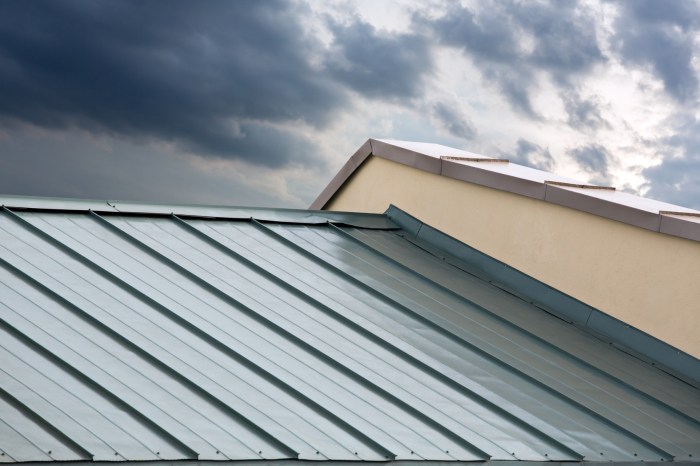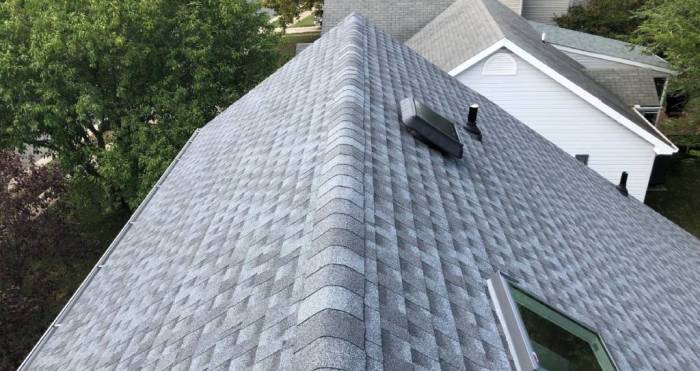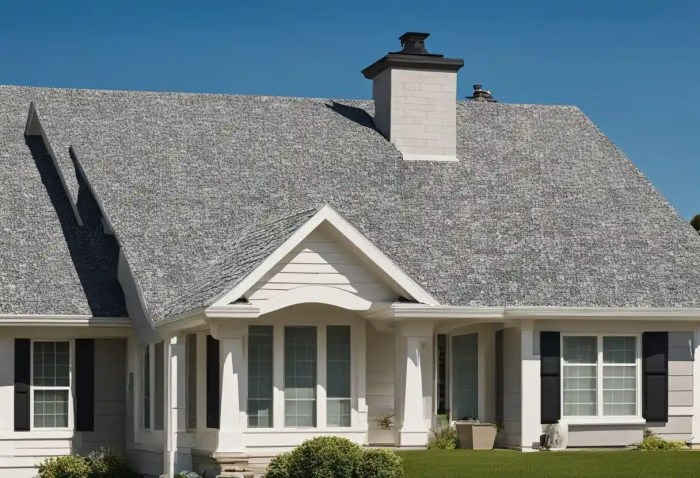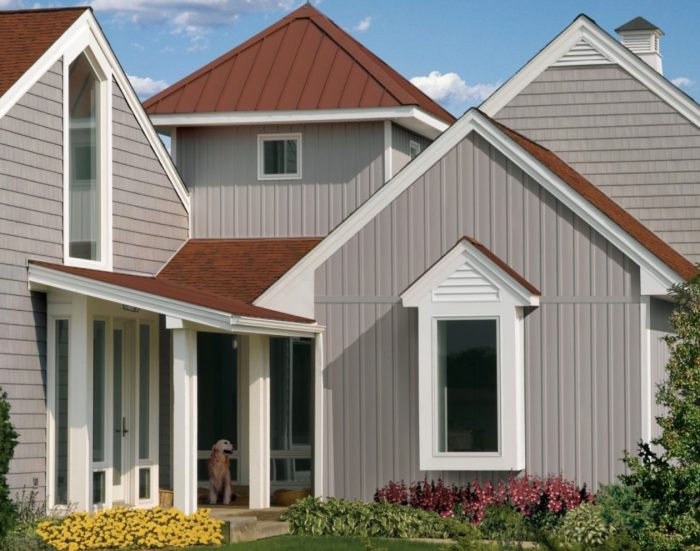Crafting Eco-Friendly: A Guide to Roofing and Siding Materials
Dive into the world of eco-friendly roofing and siding materials, where sustainability meets style. This overview will provide insights into the importance of these materials, their benefits, and how they contribute to a greener future.
Eco-Friendly Roofing Materials
Using eco-friendly materials for roofing is crucial to reduce the environmental impact of construction. These materials are sustainable, recyclable, and energy-efficient, making them a better choice for both the planet and homeowners looking to reduce their carbon footprint.
Popular Eco-Friendly Roofing Materials
- Solar shingles: These shingles harness solar energy to generate electricity for the home, reducing energy bills and carbon emissions.
- Recycled metal roofing: Made from recycled materials like aluminum or steel, this option is durable, long-lasting, and can be recycled again at the end of its lifespan.
- Wood shakes: Sourced from sustainable forests, wood shakes provide a natural and rustic look while being biodegradable and renewable.
Benefits of Eco-Friendly Roofing Materials
- Energy efficiency: Eco-friendly materials can help reduce heating and cooling costs by providing better insulation and reflective properties.
- Environmental impact: By using sustainable materials, homeowners can lower their carbon footprint and contribute to a healthier planet.
- Longevity: Eco-friendly roofing materials are often more durable and require less maintenance, leading to cost savings in the long run.
Durability and Longevity of Eco-Friendly Roofing Materials
Eco-friendly roofing materials are designed to withstand harsh weather conditions, UV exposure, and temperature changes, ensuring a longer lifespan compared to traditional materials. This durability not only reduces the need for frequent repairs but also minimizes waste generated from roof replacements.
Types of Eco-Friendly Roofing Materials

When it comes to eco-friendly roofing materials, there are several options available that are not only sustainable but also energy-efficient. Let's explore some of the popular choices in the market.
Solar Tiles
Solar tiles are a type of roofing material that harness solar energy to generate electricity for your home. These tiles are designed to blend seamlessly with traditional roofing materials, making them a visually appealing and eco-friendly option. Solar tiles can help reduce your carbon footprint and lower your electricity bills by utilizing renewable energy sources.
Metal Roofs
Metal roofs are known for their durability and longevity, making them a sustainable choice for eco-conscious homeowners. These roofs are often made from recycled materials and can be recycled at the end of their lifespan, reducing waste. Metal roofs are also energy-efficient, reflecting heat away from the building and helping to maintain a comfortable indoor temperature.
Green Roofs
Green roofs, also known as living roofs, are covered with vegetation that helps improve air quality, reduce stormwater runoff, and provide insulation. These roofs can support a variety of plants, creating a natural habitat for wildlife and reducing heat island effect in urban areas.
Green roofs are not only environmentally friendly but also aesthetically pleasing, adding a touch of greenery to your home.
Benefits of Eco-Friendly Siding Materials
When it comes to sustainable home design, eco-friendly siding materials offer a range of benefits that go beyond just aesthetics
Energy Efficiency
Eco-friendly siding materials, such as insulated vinyl siding or fiber cement siding, can help improve the energy efficiency of your home. By providing better insulation, these materials can reduce heat loss in the winter and heat gain in the summer, leading to lower energy bills and a more comfortable indoor environment.
Maintenance Requirements
One of the advantages of eco-friendly siding materials is that they often require less maintenance than traditional siding options. For example, fiber cement siding is durable and resistant to rot, insects, and fire, meaning you won't have to worry about frequent repairs or replacements.
This can save you time and money in the long run.
Impact on Indoor Air Quality
Using eco-friendly siding materials can also have a positive impact on indoor air quality. Many traditional siding materials, such as vinyl siding, can release harmful chemicals into the air over time. In contrast, eco-friendly options like reclaimed wood siding or metal siding are non-toxic and do not off-gas, ensuring a healthier living environment for you and your family.
Sustainable Practices in Roofing and Siding

Installing eco-friendly roofing and siding materials in a sustainable manner is essential for reducing environmental impact and maximizing their benefits. By following sustainable practices during installation, homeowners can ensure that their roofing and siding systems are not only eco-friendly but also long-lasting and efficient.
Recyclability and Reusability of Eco-Friendly Materials
When choosing eco-friendly roofing and siding materials, it is important to consider their recyclability and reusability. Many sustainable materials such as metal roofs, recycled shingles, and reclaimed wood siding can be recycled or repurposed at the end of their lifespan.
This not only reduces waste but also minimizes the need for new raw materials, making them a more sustainable choice for homeowners.
Tips for Maintaining and Prolonging Lifespan
To prolong the lifespan of eco-friendly roofing and siding materials, regular maintenance is key. This includes inspecting for damage, cleaning debris, and addressing any issues promptly. Additionally, ensuring proper ventilation and drainage can prevent moisture buildup and prolong the life of the materials.
By taking care of eco-friendly roofing and siding, homeowners can maximize their durability and sustainability.
Contribution to Overall Sustainability in Construction
Eco-friendly roofing and siding materials play a crucial role in promoting overall sustainability in construction. By using materials that are energy-efficient, recyclable, and durable, homeowners can reduce their carbon footprint and minimize environmental impact. These sustainable choices not only benefit the environment but also contribute to creating healthier and more efficient buildings for the future.
Last Word
In conclusion, eco-friendly roofing and siding materials offer a sustainable and durable solution for homes, while also reducing environmental impact. Embrace these materials for a greener tomorrow.
Essential Questionnaire
Are eco-friendly roofing materials more expensive than traditional options?
Eco-friendly roofing materials can have a higher upfront cost but provide long-term savings through energy efficiency and durability.
Do eco-friendly siding materials require special maintenance?
While they may have specific care requirements, eco-friendly siding materials generally require less maintenance compared to traditional options.
How do eco-friendly roofing materials impact indoor air quality?
Eco-friendly roofing materials can help improve indoor air quality by reducing the use of toxic chemicals and promoting better ventilation.




